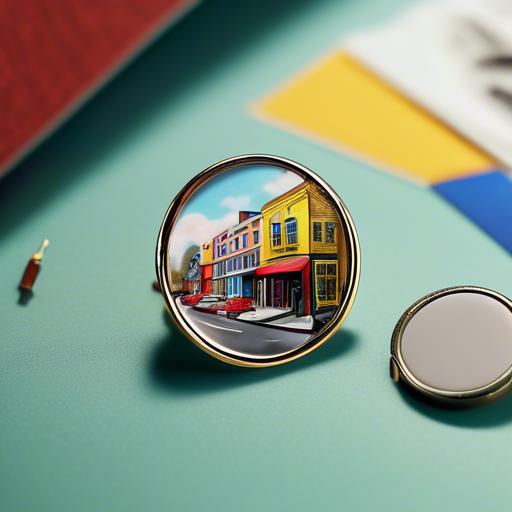Have you ever wondered how those little works of art known as lapel pins are made? From the initial design phase to the final polishing, the process behind creating these unique accessories is both fascinating adn intricate. Join me as we delve into the world of lapel pin production and discover the secret behind their beauty and charm.
The Art of designing lapel Pins
Designing lapel pins requires a unique blend of creativity and precision. Crafted with intricate details, these small accessories can make a big statement. To create a lapel pin, designers start by sketching out ideas and concepts, often drawing inspiration from various sources such as nature, art, or pop culture.
Once the design is finalized, it is then turned into a digital file using specialized software. This digital file is used to create a mold, which is then filled with molten metal to form the shape of the pin.The pin is then polished, painted, or engraved to add the finishing touches, resulting in a beautiful and unique piece of wearable art.
Crafting Lapel Pins through the Enameling Process
Lapel pins are meticulously crafted through a specialized process known as enameling. This intricate technique involves several steps that transform plain metal into stunning,colorful accessories. The following steps outline how these unique lapel pins are made:
- Metal casting: The base metal,typically brass or copper,is poured into molds to create the desired shape of the lapel pin.
- Polishing: The metal pins are polished to ensure a smooth and shiny surface,which is essential for the enamel to adhere properly.
- Enameling: The enamel is applied to the metal pins in multiple layers, with each layer baked at high temperatures to create a durable and vibrant finish.
- Detailing: Intricate designs or logos are then added to the pins through techniques such as screen printing or laser engraving.
- Finishing Touches: The lapel pins are finally plated with gold, silver, or other finishes to enhance their overall appearance.
Through the enameling process, artisans are able to transform raw materials into beautiful and eye-catching lapel pins that can be worn proudly on jackets, bags, or hats. Whether representing a company, organization, or cause, these handcrafted pins are a unique and stylish way to make a statement.From the initial metal casting to the final finishing touches, each step of the process is crucial in creating a high-quality lapel pin that is sure to stand out.
Manufacturing Lapel pins with Precision and Attention to Detail
Lapel pins may seem like small accessories, but their intricate designs and high level of craftsmanship require precision and attention to detail during the manufacturing process. The first step in creating lapel pins is designing the artwork, which can include logos, symbols, or custom designs. Once the artwork is finalized, it is transformed into a digital file that will be used to create the mold for the pin.
Next, the mold is created using a process called die striking, where a die is pressed onto a blank piece of metal to create the desired shape. the metal is then plated with various finishes such as gold, silver, or enamel to achieve the final look.Quality control is crucial throughout the manufacturing process to ensure that each lapel pin meets the highest standards. The end result is a beautifully crafted accessory that can be worn with pride and showcases the dedication and skill that goes into manufacturing lapel pins.
Tips for Choosing the Best Lapel Pin Manufacturer
When it comes to choosing the best lapel pin manufacturer, there are several key factors to consider that can ensure you receive a high-quality product. One crucial tip is to look for a manufacturer that has a good reputation in the industry. You can do this by reading reviews and testimonials from previous customers to gauge their level of satisfaction with the pins they received.
another factor to consider is the materials and techniques used in the manufacturing process. Quality lapel pins are typically made from durable materials like brass or stainless steel, and are created using methods such as die striking or soft enamel. It’s also important to choose a manufacturer that offers custom design options, so you can create a unique lapel pin that perfectly represents your brand or organization.
Q&A
Q: How are lapel pins made?
A: Lapel pins are made through a process called die striking. This involves creating a design on a metal strip, then using a die to stamp the design onto the metal, creating the pin.
Q: What materials are used to make lapel pins?
A: Lapel pins are typically made from metal, such as brass, copper, or iron.They can also be plated with materials like gold, silver, or nickel to give them a specific finish.
Q: How are lapel pins designed?
A: Lapel pins are designed using computer-aided design (CAD) software. The design is then transferred onto a metal strip, which is used in the die striking process.
Q: Are lapel pins customizable?
A: yes, lapel pins are highly customizable. They can be made in various shapes, sizes, and colors to suit the needs of the customer. Custom designs and logos can also be incorporated into the pin.
Q: What is the final step in making lapel pins?
A: the final step in making lapel pins is adding a back closure, such as a butterfly clutch or a pin back. This allows the pin to be attached securely to clothing or accessories.
In Retrospect
As I delved into the intricate process of how lapel pins are made, I gained a newfound appreciation for the artistry and skill that goes into creating these small but impactful accessories. From the initial design stage to the final polishing and finishing touches, each step is meticulously executed to ensure the highest quality end product. It’s truly fascinating to see the combination of modern technology and traditional craftsmanship come together to produce something so small yet so significant. The next time you pin one of these little works of art to your lapel, take a moment to appreciate the craftsmanship and dedication that went into creating it. And remember, behind every lapel pin is a story waiting to be told.


